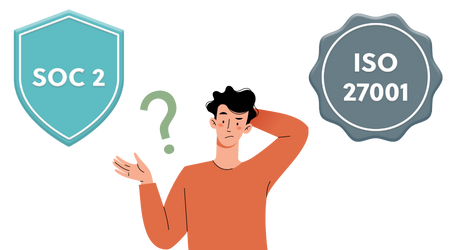SOC 2 and ISO 27001 are compliance frameworks commonly required of organizations that house data or store sensitive information. Both standards focus on information security management, but they have some key differences in their approach and scope.
Let’s take a closer look at the differences between SOC 2 and ISO 27001, and see if one or both are right for your organization.
What are the Differences Between SOC 2 vs. ISO 27001?
Scope
SOC 2 focuses specifically on the five Trust Services Criteria: security, availability, processing integrity, confidentiality, and privacy data in the cloud.
There are no predefined set of controls, so a company is able to pick the controls it wants to test, which may make it easier to achieve. This approach is favorable for a young company that is still building its security functions.
ISO 27001 is a broader standard that covers information security management systems (ISMS) in general, including all types of information, not just data in the cloud.
Unlike SOC 2, ISO is measured against a rigid controls framework. It also requires more time and money, so although the framework says it’s applicable for any organization, this one-size-fits-all approach doesn’t work well with less mature companies.
Market
Both frameworks are recognized globally, but SOC 2 is commonly used in the US, and ISO 27001 is used both in the US and internationally.
The Process, Third-Party Audits, & Deliverables
Both SOC 2 and ISO 27001 require a third-party audit to receive either an attestation report (SOC 2) or a certification (ISO 27001).
SOC 2 is not a certification, but an attestation report. There are also two types: SOC 2 Type 1 and SOC 2 Type 2. After an organization has figured out which type to pursue and document the scope of the audit and its policies, they must hire a licensed CPA (Certified Public Accountant) to look into the internal controls (that protect customer data), to make sure they’re legitimate. Only then can the CPA firm attest on the organization’s behalf.
From the firm’s POV, the SOC 2 process would look something like this:
- Review the scope of the audit
- Develop a plan
- Test the controls
- Document the findings
- Deliver the SOC 2 attestation report
From the internal side, it would have two parts:
- Part 1: A Readiness Assessment. This review period acts as a dry run before the official. Although it’s optional, it’s a good idea to conduct. By flagging things early on, money and resources won’t be wasted later. This can be done within the organization, or by a third party.
- Part 2: The Official Audit. If gaps were identified in the last part, then this review would make sure that those same gaps have been improved on and closed.
For guidance on which SOC 2 type is best for you, check out our Intro to SOC 2 guide.
ISO 27001 is a certification that must be certified by a ISO 27001-accredited body.
Similarly to SOC 2, this audit has two parts:
- Part 1: Documentation Assessment. The auditor or certifier will check to see if the requirements – having security controls that protect customer data and an operational ISMS in place – are present. If there are any gaps, the auditing body will identify the areas of improvement.
- Part 2: Certification Audit. If gaps were identified in the last part, then this review would make sure that those same gaps have been improved on and closed.
For a deeper dive into the ISO review process, here’s our Intro to ISO 27001 guide.
Choosing Between SOC 2 vs. ISO 27001
SOC 2 is relatively more affordable and faster to achieve, but ISO is a universal standard around the globe, and its certification is recognized by all industries in all regions. On the other hand, ISO usually takes about 50 – 60% more time to complete, and it costs 50 – 60% more as well.
Neither SOC 2 or ISO is mandatory, but acquiring them helps you:
- Build trust with potential customers
- Pass security reviews and win business
- Stay on track with compliance and regulatory requirements
- Evaluate and improve data security practices on a regular basis
So, how would one know which one to pursue?
It depends on a multitude of factors, such as how mature your company is, where it’s located, where your customers are, where and how you want to grow, and how many resources you have at your disposal. A critical factor is customer requirements; if your customers expect one or both of these frameworks, then they may be required to do business.
Still need a bit more information, or want to learn more about other frameworks? Be sure to check out our other guides on SOC 2, ISO 27001, HIPAA, and GDPR, CCPA & ISO 27701.



